Last Updated on July 6, 2024 by
After visiting the Mahakuta Temples, my next stop while exploring the heritage monuments of Badami, Aihole and Pattadakal was Aihole. While Badami cave carvings blew my mind, I was excited and looked forward to exploring Aihole Temples. These temples of Karnataka are a must-visit if you are an ancient architecture lover!
The sun was already beating down by the time I reached Aihole village. The car crossed through many structures that resembled temple architecture and my car driver was quick to add that the entire village of Aihole hosts over 120 temples. Some temples have not survived the test of time while some are revived by the Archeological Survey of India (ASI). This gave me a feeling of Angkor Wat where there are many temples, all spread across a huge area.
Table of Contents
History of Aihole
Before going to Aihole, I couldn’t help but notice the number of questions for Aihole in UPSC. This led me to read more about Aihole history and Aihole inscriptions. According to the ancient inscriptions in Aihole, the village was earlier named “Ayyavole” and “Aryapura. I wondered who built Aihole and the answer was Ravikeerti, Commander and Minister of Pulakesin II in 634 AD.
The temples in Aihole were built during the period of Chalukyas is between the 7-8th century. The temples are dedicated to Hinduism and Jainism and have beautiful architecture. Maybe that is the reason why Aihole is called the cradle of Indian temple architecture. The architecture of the temple is predominantly Dravida with Nagara style.
Legend associated with Aihole
According to the legend, Bhagwan Parashuram after avenging the death of his father came down to the river Malaprabha and washed his blood-stained hands and battle axe. The blood and gore on the axe turned the river red. A woman saw this and screamed ‘Ayyo Hole’ meaning ‘Oh No Blood!’ in Kannada the local language. The dialect over the years turned Ayyo Hole into Aihole.
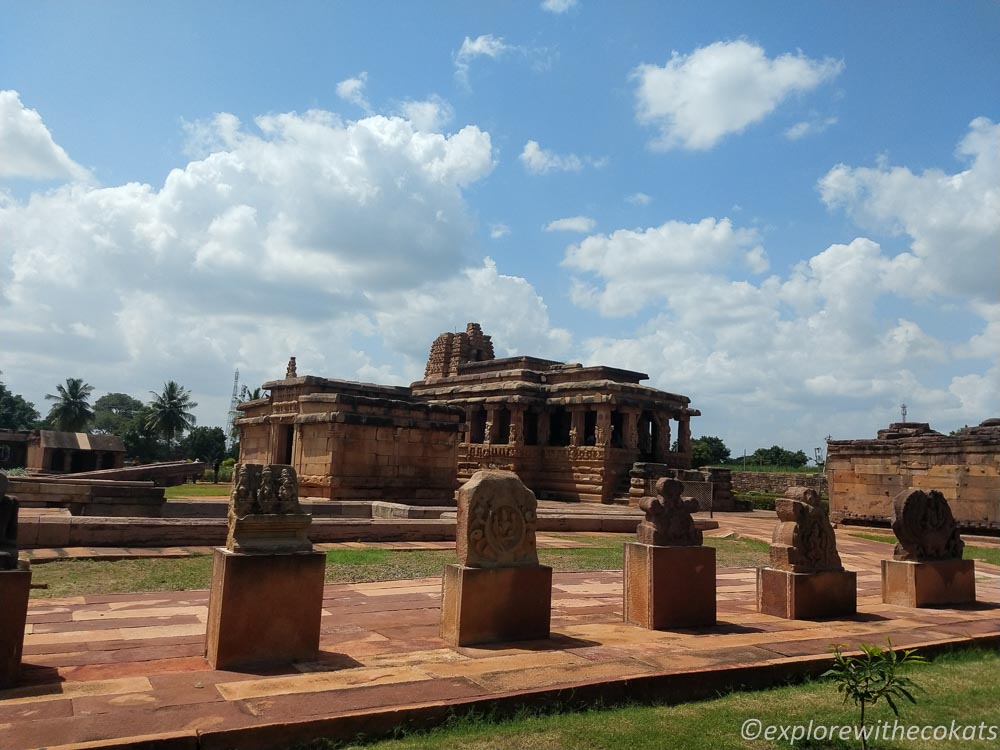
Aihole Architecture
It is said the architects and artists who built Aihole temples were still trying to perfect their preferred style of temple. There are a lot of places that are a reflection of many kinds of architecture.
Like most Chalukyan architecture, the temples in Aihole are built cutting the rocks. In most areas of the Bagalkot district, red sandstone is prominent which is the rock used in this temple architecture. The towers of the temples were carved with a blind arch which was inherited from the North Indian style.
The Aihole Inscription
The Aihole Inscription is believed to have been composed by the Jain poet Ravikeerthi. The inscription dates back to 634 CE and is written in a combination of Sanskrit and the old Kannada script.
It contains details of the achievements of Pulakesi II, especially his victory against Harshavardhana, the ruler of Northern India.
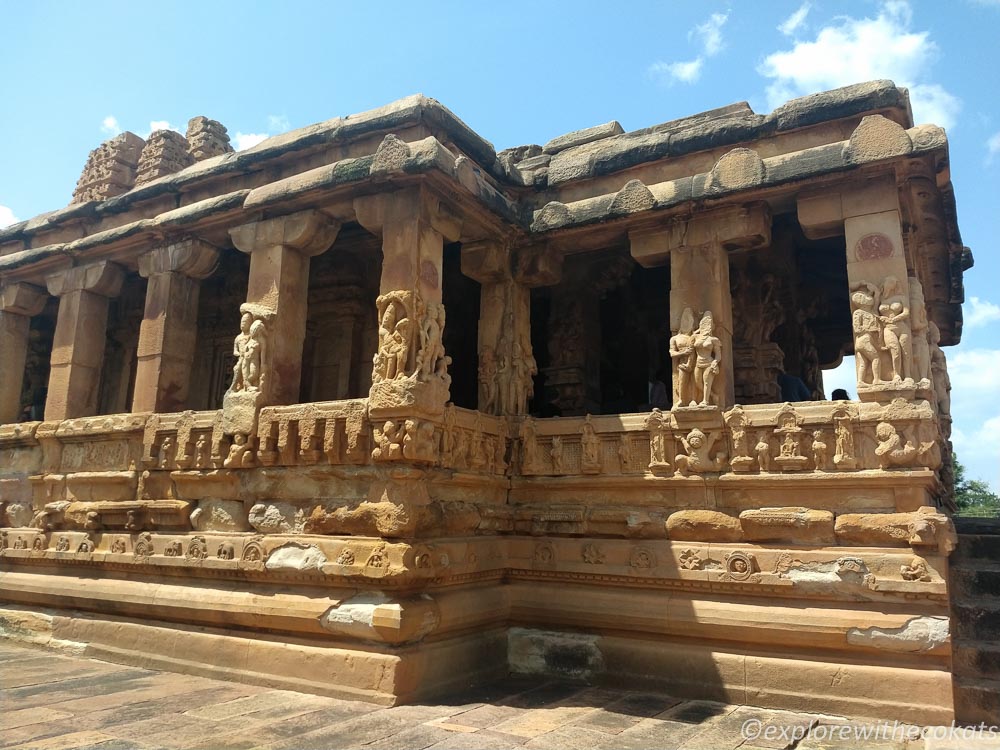
Temples of Aihole
There are many temples in Aihole complex overlooking a beautiful and manicured garden. This complex also houses an archeological museum.
Durga Temple
Aihole is famous for Durga temple. The Durga temple is horseshoe-shaped, incidentally named, not for the deity, but because there was a fort wall. Durga Temple is also known as Fortress Temple and was originally dedicated to Sun God.
Durga temple, Aihole is semi-circular in its plan. The back resembles the hind part of an elephant. The temple comprises a semicircular sanctum placed within a pillared hall and a square porch. The entire structure is placed within a larger semicircular cage-like structure.
Visitors have to climb steps from the south to get awed by the relief sculptures on the pillars and niches. There are sculptures of embracing couples like Asvamukhiyakshi, Surya and Chhaya, Narsimha, and Ardhanari. Other sculptures include Shiva, Nandi, Vishnu riding Garuda, Varaha, Harihara, and others. There are also depictions of Ramayana episodes on the pedestal of the porch.
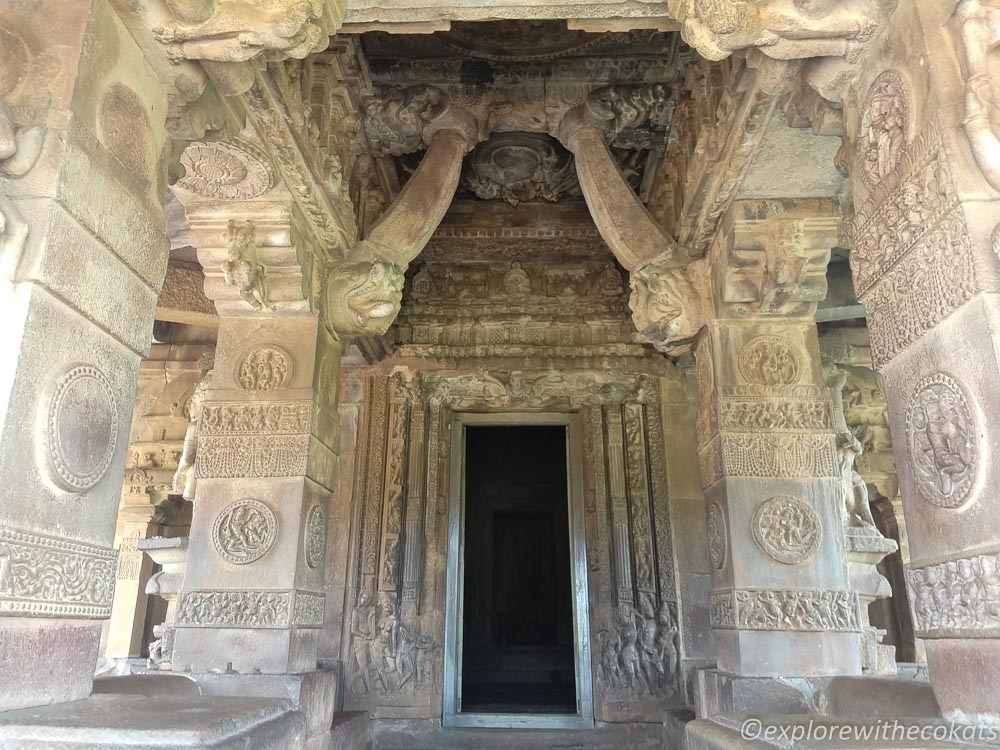
Lad Khan Temple
The Lad Khan Temple is known by the name of a Muslim man who lived in the temple before the British Archaeologists drove him out. This is one of the oldest temples in Aihole, dating back to 450 AD.
The Lad Khan temple has two mandapas that look like Shiva Linga. These mantapas are Mukha Mandapa and Sabha Mandapa. The Mukha Mandapa rests on twelve pillars while the pillars on which the Sabha Mantapa rests are arranged in two concentric squares. The pillars here have some interesting designs on them, such as the emblem of the Chalukyas, the boar, and a mirror, with the conch and wheel, representing the Varaha form of Vishnu, their tutelary deity.
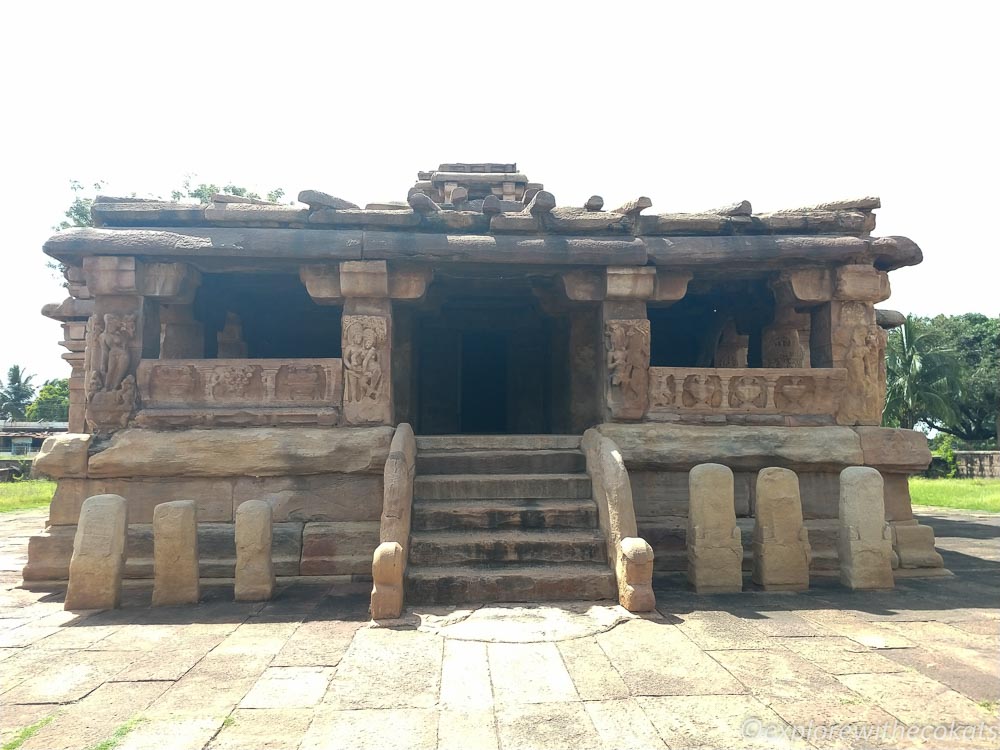
The Archaeological Museum, Aihole
The Archaeological Museum is located within the Durga Temple complex in Aihole. The museum houses 381 antiquities mainly consisting of stone sculptures of Brahmanical, Jaina, and Buddhist faith, fragmentary carved architectural members, inscriptions, hero stones, sati stones, etc. These sculptures range in date from 6th century CE to 15th century CE. The museum is divided into six galleries and an open-air gallery. Out of 381 antiquities, 145 are displayed in six galleries inside the museum and open air gallery.
The huge open-air gallery has more than forty sculptures comprising mainly Herostones, Ganesh, Saptamatrikas, seated figures in the Chaitya arch, Jainas sculptures, Naga and Nagini figures dating from the 7th to 10th centuries of the Chalukyas of Badami and the Rashtrakutas, are displayed.
Gaudara Gudi
This early Chalukya temple stands on an elevated pedestal. It consists of an open rectangular pillared hall with a rectangular sanctum within. The roof is flat at the center and sloping on all four sides. The sanctum’s exterior walls have empty niches decorated with north Indian-style pediments. A Kannada inscription of the 8th century on a beam confirms its dedication to Maa Durga.
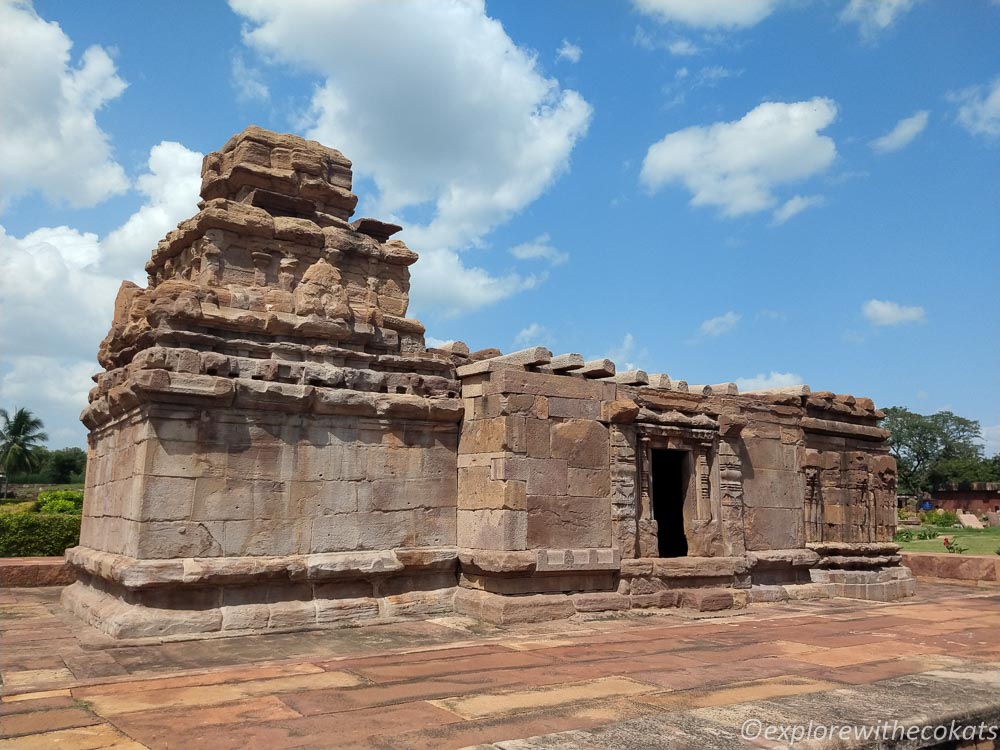
Other group of Aihole temples around the village
Ravana Phadi Cave
Ravana Phadi Cave temple was built in the sixth century. It has a rectangular shrine with two mantapas. There is an inner room where a Shiva Linga is established. There are large figures of Lord Shiva on the walls which also include the statue of Nataraja.
Group of Yeniar Shrines
The group of Yeniar shrines consists of eight temples that were built in the 12th century. Each temple has a porch along with a cellar and a hall. The temples were constructed on the banks of Malaprabha river.
Ramalinga Group of Temples
The main temple in this group is Ramalinga which is a trikutachala shrine. Out of these three, two have Shiva Linga and the third has the image of Goddess Parvati. This shrine was built in the 11th century AD. Along with these, there are two towers called Kadambanagara towers which was a temple form of architecture founded in the 4th century by Mayurasharma, founder of Kadamba dynasty.
Jyotirlinga Complex
There are 16 big and small temples in this complex. While most of them are ruined, they still have beautiful sculptures. There is a Vishnu temple here in Kalyana Chalukya style from the 11th century. Other temples in the complex are dedicated to Mahishamardini. Surya, Sangamanatha, Brahma as well as Parashuram.
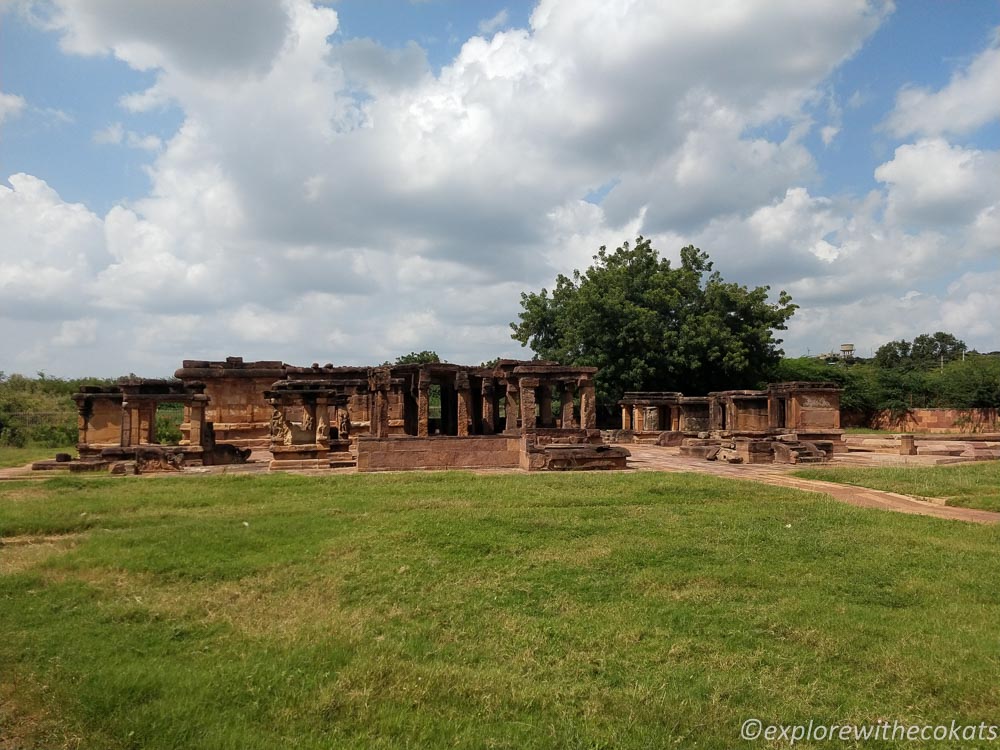
Galaganatha Group of Temples
Galaganatha Group of Temples were built on the banks of Malaprabha river in which the main Shrine is Galaganatha which has the statue of Lord Shiva. The images of Ganga and Yamuna can be found at the entrance. The total number of temples in this group is 38 and besides Galaganatha, most of them are ruined.
Huchchappayana Matha
This temple is divided into two sections and sits in a huge manicured garden. Although when I went, the locals were resting in the complex and even were drying clothes on the structures.
This temple has sculptures on its exterior walls, columns, and inner ceiling. The door frame of the Garbhagriha is very well-wrought with Ganga and Yamuna images. There are also impressive figures of an amorous couple.

Aihole Timings
The temples can be visited from 9:00 am to 6:00 pm every day. If you are visiting with a guide, it will easily take up a full day in case you want to visit all the important temples and understand the sculptures.
Aihole Ticket Price
Aihole entry fee is INR 35 for Indian Nationals and INR 300 for Foreign Nationals. There is no separate camera charge.
How to Reach Aihole
Aihole has only a road network so it is easy to reach here by road. It does not have an airport or a railway station. The nearby railway stations are Bagalkot and Badami both located 34 km. Belgaum and Goa are the nearest airports located approximately 230km away from Aihole.
By Air
Aihole does not have an airport but the nearest airport is Belgaum and Goa which is 230km away from Aihole. Goa airport or Dabolim airport is an international airport that connects Goa from cities in India and abroad. One has to hire a taxi from the airport to reach Aihole. There are public buses available from Belgaum to reach Badami.
By Train
Aihole does not have a railway network but the nearest railway station is Bagalkot and Badami which is 34km away from Aihole. Bagalkot is well-connected with many cities though very few trains have a stop here.
By Road
Aihole does not have a bus station but buses come to nearby cities like Badami, Hubli, Bagalkot etc. Tourists can catch a taxi from there to reach Aihole. Pattadakal is connected with Aihole through National Highway No. 14.
Local transport in Aihole
Although Aihole is a village, the temples are located in many areas and it may be difficult to cover all of them on foot. It is best to hire a taxi or drive your own car.
Where to Stay in Aihole
Aihole is a small village so there are no hotels or homestays. But Bagalkot has good accommodation options which are around 34km away from Aihole. Even Badami has good options. You can check out accommodation options from my post: Rock-cut Badami cave temples. Following are some of the options from Bagalkot.
Three Star-Hotels: Hotel Heritage Resort, Homestay Inn
Budget Hotels: Hotel Priya International, Hotel Anugraha Deluxe, Hotel Chalukya Deluxe
Best Time to Visit Aihole
The best time to visit the Aihole is October to March as the weather is very pleasant in these months and visitors can enjoy their time. The climate is mild to moderate cold in December and January. The period from April to September is hot and is not suitable to visit. Bagalkot receives less rainfall but is extremely hot and humid between June to September. However, you can expect lush green surroundings and gorgeous countryside during the monsoon.
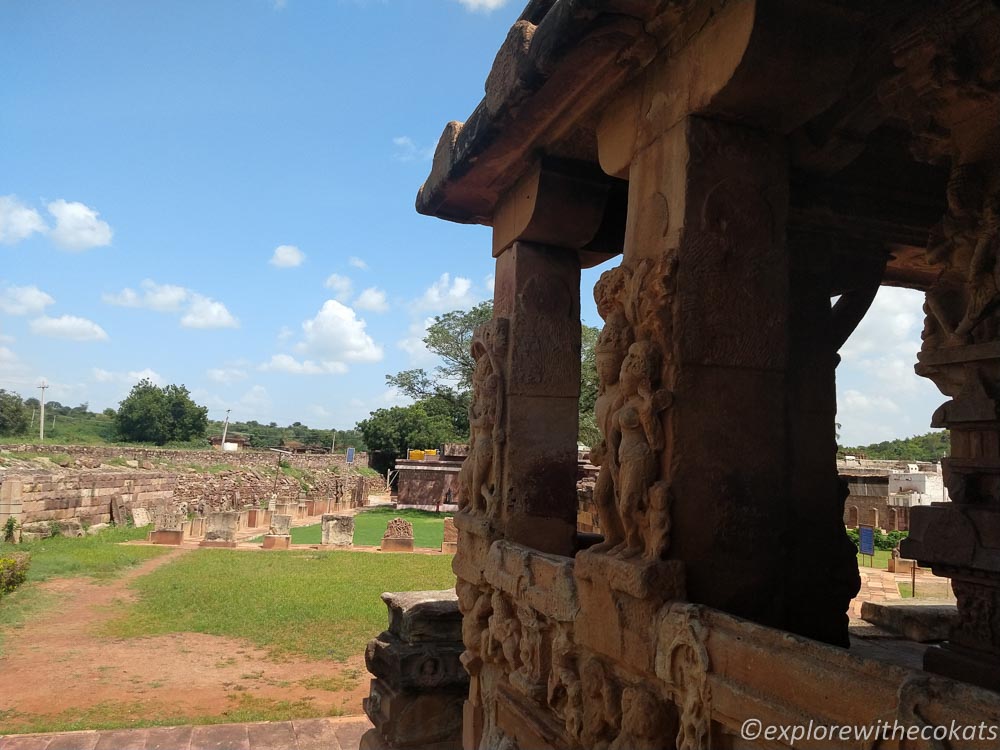
Do’s and Don’ts to plan a trip
- Aihole and its nearby areas are extremely hot and humid during the day. I visited in Mid-September which is monsoon and yet it was not pleasant. It is best to carry a cap/hat/stole and sunglasses.
- Wear clothes that are loose, comfortable and sweat absorbing.
- Wear a pair of comfortable footwear as you will be walking a lot.
- Carry a bottle of water and some snacks for a quick hunger bite.
- Paying for Aiole entry fees by debit or credit cards comes with a discount as against cash.
- Photography and videography using drones or tripods is strictly prohibited at Aihole.
Sustainable tips for Aihole village
- Respect the ancient sculptures by not sitting on them.
- Do not harm the sculptures by carving, writing or spitting on it.
- Dispose of garbage in the dustbins located at specific points.
- Treat these monuments with respect and do not use them for picnics.
Read More posts from Karnataka
- Aihole – The ancient temple town
- Mahakuta temples of Karnataka
- Rock-cut Badami cave temples
- All about Belgaum
- Things to do in Nirvana Beach, Kumta
- Coracle ride at Talakadu Beach
- Shivanasamudra Falls
Disclaimer – This post contains affiliate links. It means it adds no extra cost to you if you book through the link but I get a referral bonus which helps me earn a little to keep this website up and running.
Pin this post!
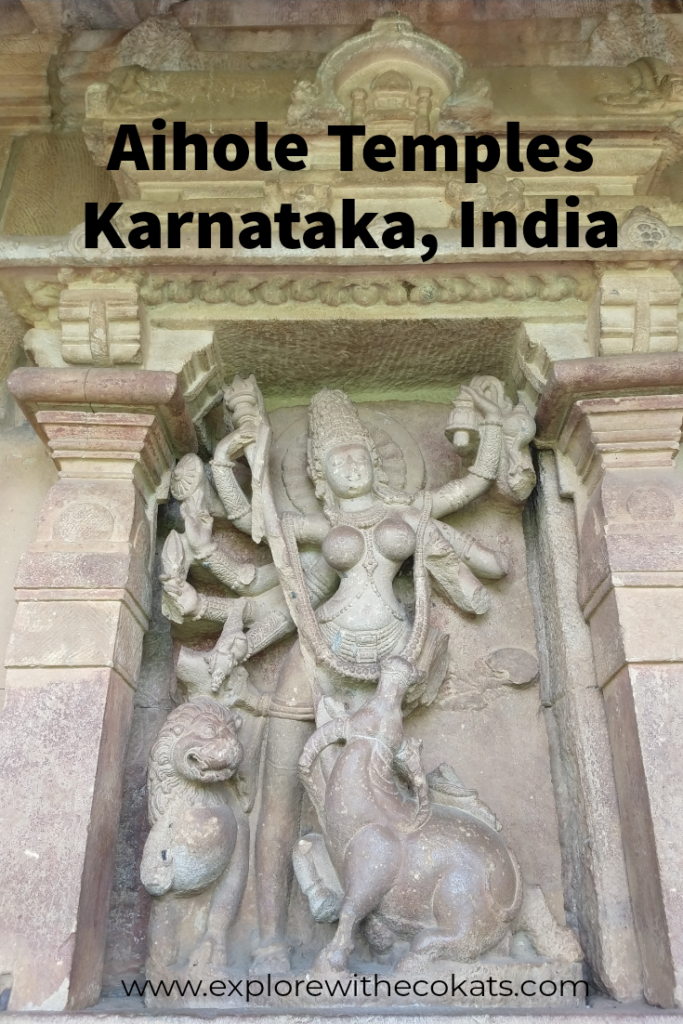

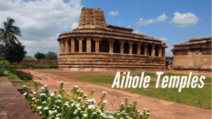
2 comments
You always visit the most interesting temples! This is another one that I hadn’t heard about before, but it looks amazing to visit and a nice day.
I love the Indian temples because the architecture intrigues me. It is always mind-boggling given the fact they were built thousands of years ago!